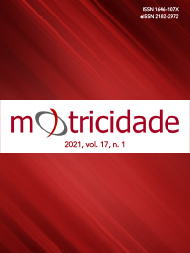Impact of Sex, Age and Practice Time on Self-Efficacy in Brazilian Volleyball High-Level Athletes
DOI:
https://doi.org/10.6063/motricidade.20869Abstract
The objective of this study was to investigate the relationship between age and practice time with the self-efficacy in volleyball athletes according to sex and the relationship between age and practice time with general self-efficacy, as well as to verify how these aspects impact the beliefs of volleyball players' efficacy. High-performance volleyball athletes (n= 300), mean age was 24.88± 5.51 years, and the meantime of experience was 11.12± 5.24 years answered the Volleyball Self-Efficacy Scale and the Perceived General Self-Efficacy Scale. Age and practice time are correlated with the Global Self-Efficacy in Volleyball and the dimensions Self-Efficacy in the Game, Defensive Self-Efficacy in Volleyball and Offensive Self-Efficacy in Volleyball of men athletes, female, men, and women. Perceived General Self-efficacy is related to the age and practice time of female athletes and female and male athletes of both sexes. These variables represent important aspects for the construction and solidification of positive beliefs of athletes of both sexes regarding their specific abilities and for women for general self-efficacy in life.
Keywords: self-efficacy; volleyball; athletes.
Downloads
Published
Issue
Section
License
The authors of submitted manuscripts must transfer the full copyright to Journal Motricidade / Sílabas Didáticas Editions. Granting copyright permission allows the publication and dissemination of the article in printed or electronic formats, and copyrights start at the moment the manuscript is accepted for publication. It also allows Journal Motricidade to use and commercialise the article in terms of licensing, lending or selling its content to indexation/abstracts databases and other entities.
According to the terms of the Creative Commons licence, authors may reproduce a reasonable number of copies for personal or professional purposes, but without any economic gain. SHERPA/RoMEO allows authors to post a final digital copy (post-printing version) of the article on their websites or on their institutions' scientific repository.


